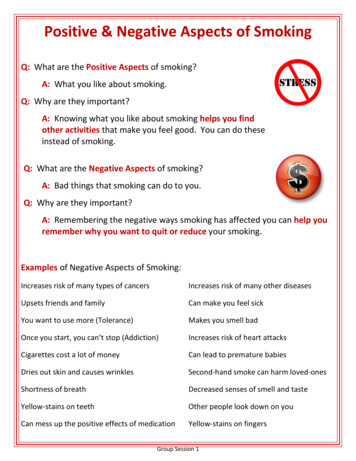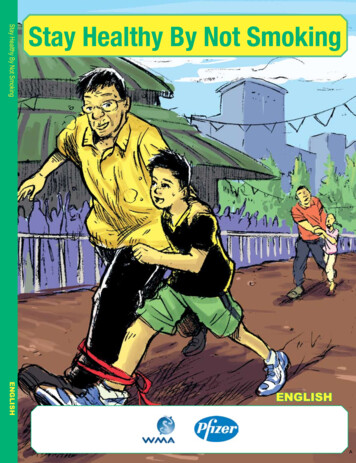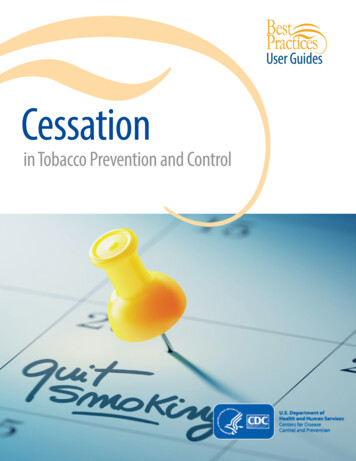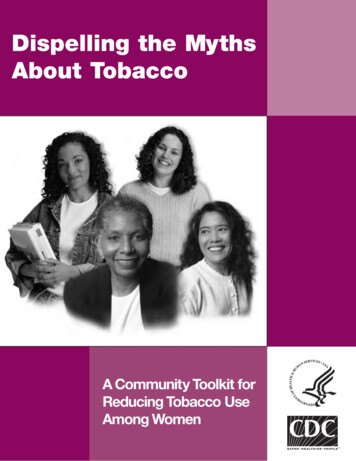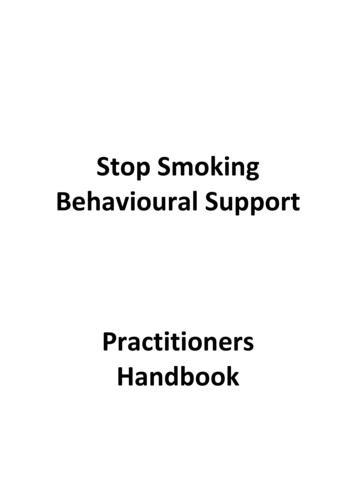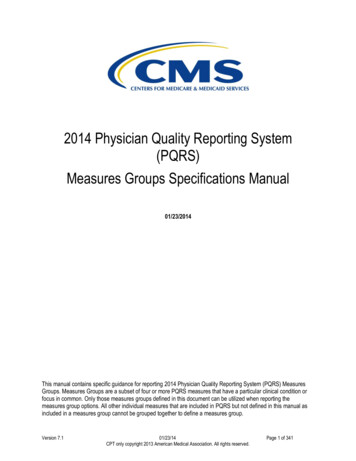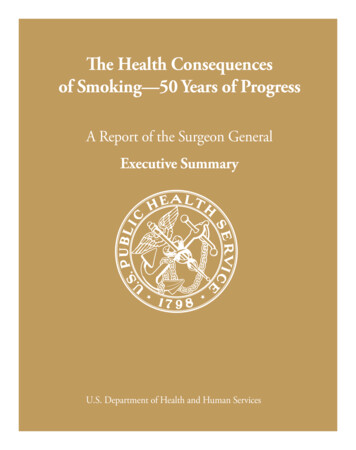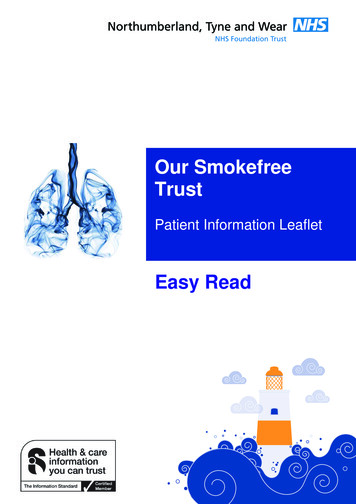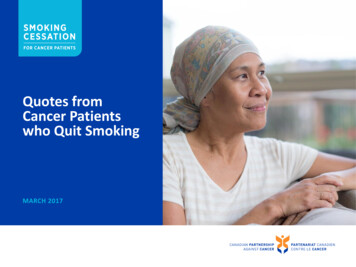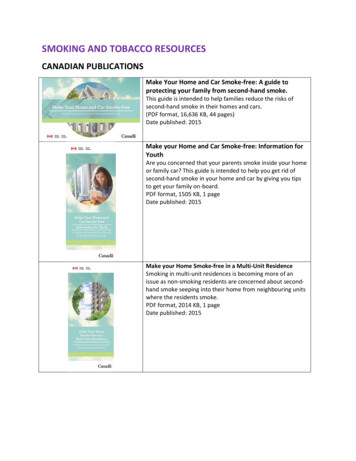
Transcription
SMOKING AND TOBACCO RESOURCESCANADIAN PUBLICATIONSMake Your Home and Car Smoke-free: A guide toprotecting your family from second-hand smoke.This guide is intended to help families reduce the risks ofsecond-hand smoke in their homes and cars.(PDF format, 16,636 KB, 44 pages)Date published: 2015Make your Home and Car Smoke-free: Information forYouthAre you concerned that your parents smoke inside your homeor family car? This guide is intended to help you get rid ofsecond-hand smoke in your home and car by giving you tipsto get your family on-board.PDF format, 1505 KB, 1 pageDate published: 2015Make your Home Smoke-free in a Multi-Unit ResidenceSmoking in multi-unit residences is becoming more of anissue as non-smoking residents are concerned about secondhand smoke seeping into their home from neighbouring unitswhere the residents smoke.PDF format, 2014 KB, 1 pageDate published: 2015
It will never happen to meEighty-five per cent of all smokers start before their 19thbirthday. Don't become a tobacco statistic!PDF format, 531 KB, 1 pageDate published: 2002On the Road to Quitting - Guide to becoming a non-smokerIf one of your goals is to become tobacco-free, then recognizethat you have the power to make it happen. Prepare for asuccessful quit attempt by arming yourself with information.PDF format, 3047 KDate published: 2012On the Road to Quitting - Guide to becoming a non-smokerfor young adultsNo matter how near or far you are from your goal of quittingsmoking, this booklet will help you figure out what you wantto do and provide the information you need to move forward.PDF format, 3130 KDate published: 2012Quit4LifeDid you know that it takes more than will power to quitsmoking? It takes skills and support, as well as your ownmotivation to quit. The new Quit4Life (Q4L) handbook canhelp you to quit smoking. for life.
Smoking Cessation in the Workplace: A Guide to HelpingYour Employees Quit SmokingThis guide is for employers and others who promote health inthe workplace. It outlines the reasons why workplaces shouldget involved and support employees' efforts to cut down orquit smoking.PDF format, 1734 KDate published: 2008Tobacco: A deadly product1 Canadian dies from tobacco-related illness every 14 minutes115,000 Canadians became daily smokers in 201582% of current daily adult smokers had their first cigarette bythe age of 181 in 4 Canadian youth aged 15-19 have tried a vaping productPDF format, 260 KB, 1 pagesPublished: 2016-11-22Smoking Cessation During Pregnancy and Relapse AfterChildbirth in CanadaWomen who smoke during pregnancy have a higher risk ofstillbirth or preterm delivery, and their babies are atincreased risk of low birth weight and of death in their firstyear of lifePDF format, 216 KB, 2 pagesDate published: 2016-05-17Carcinogens in Tobacco SmokeTobacco smoke contains over 4,000 chemicals, of which morethan 70 are known to cause, initiate or promote cancer andare called "carcinogens".Exposure to tobacco smoke increases the risk of developingcancer.Health Canada recommends that Canadians stop smoking andavoid second-hand smoke.
For Smokers Who Want to QuitCanadian Cancer SocietyThis booklet is for smokers who have decided that they wantto quit smoking.For Smokers Who Don’t Want to QuitCanadian Cancer SocietyThis booklet is for smokers who don’t want to quit smoking.Help a Smoker QuitCanadian Cancer SocietyThis booklet is to help a smoker quit smoking.
US PUBLICATIONSThe Impact of Tobacco UseTobacco has serious effects on the health of users. Forexample, smoking harms nearly every organ in the bodyand leads to premature death.1 The consequences oftobacco use threaten Americans in many waysThe Health Consequences of Smoking – 50 Years ofProgress- A Report of the Surgeon General1. Smoking – adverse effects. 2. Tobacco Use Disorder –complications. 3. Smoking – prevention & control. 4.Health Promotion – trends. I. United States. Public HealthService. Office of the Surgeon General. II. National Centerfor Chronic Disease Prevention and Health Promotion(U.S.). Office on Smoking and HealthThe Health Consequencesof Involuntary Exposureto Tobacco Smoke-A Report of the Surgeon GeneralThis twenty-ninth report of the Surgeon Generaldocuments the serious anddeadly health effects ofinvoluntary exposure to tobacco smoke. Secondhandsmoke isa major cause of disease, including lung cancerand coronary heart disease, in healthynonsmokers.
How Tobacco Smoke Causes DiseaseThe Biology and Behavioral Basis for SmokingAttributable Disease-A Report of the Surgeon GeneralThe enormous public health and financial impact on thisnation from tobacco use is completelyavoidable. Until weend tobacco use, more people will become addicted,more people will become sick,more families will bedevastated by the loss of loved ones, and the nation willcontinue to incur damagingmedical and lost productivitycosts.Let’s Make the Next Generation Tobacco-Free: YourGuide to the 50th Anniversary Surgeon General’s Reporton Smoking and HealthA short, easy-to-read booklet that summarizes historicalinformation on changes in smoking norms since therelease of the first Surgeon General's Report in January1964, new findings on causes, and solutions.[PDF–36.6 MB]Women and SmokingThis fact sheet is for public healthprofessionals who are interested ininformation on how smoking affectswomen’s health.
Smoking and YouthThis fact sheet is for public health officialsand others who are interested in informationon smoking and other tobacco use by youth.SMOKING AND RESPIRATORY DISEASESThis fact sheet is for public health officials and otherswho want information on the many ways smokingdamagesthe respiratory system.SMOKING AND REPRODUCTIONThis fact sheet is for publichealth professionals andotherswho want informationon the many ways smokingaffectsreproduction,pregnancy, and the health ofthe fetus andthe mother.
SMOKING AND DIABETESThis fact sheet is for public health officials and otherswho are interested in learning about the impact ofsmoking on diabetes. People who want to lower their riskfor diabetes, and people who already have diabetes,should not smoke.SMOKING AND CARDIOVASCULAR DISEASEThis fact sheet is for public health officials and otherswho are interested in how smoking affects the heart andcirculatory system. Smoking is very dangerous tocardiovascular health.SMOKING AND CANCERThis fact sheet is for public health officials and otherswho are interested in information on smoking and cancerrisks. People who want to lower their risk for cancershould not smoke.
WHAT YOU NEED TO KNOW ABOUT SMOKINGAdvice From Surgeon General’s Reports on Smoking andHealthSmoking remains the leading preventable cause of deathand disease in the United States. Recent studies showthat smokers who talk with a clinician about how to quitdramatically increase their chances of quittingsuccessfully. Quitting smoking is the most important stepyou can take to improve your health. Your doctor canhelp you quit.Current Cigarette Smoking AmongAdults — United States, 2005–2015Tobacco use is the leading cause of preventable diseaseanddeath in the United States, and cigarettes are the mostcommonly used tobacco product among U.S. adultsRisks from SmokingSmoking can damage every part of the body
Poison center callsinvolving e-cigarettesAnnual Deaths Attributable to Cigarette Smoking—United States, 2005–2009Harmful and Potentially Harmful Constituents (HPHCs)inTobacco ProductsOne of the goals of the Federal Food, Drug, and CosmeticAct is to help people understand the potential harms oftobacco use. The Act requires tobacco productmanufacturers and importers to report the amount ofharmful and potentially harmful constituents (HPHCs) bybrand and subbrand. HPHCs are chemicals or chemicalcompounds in tobacco products or tobacco smoke thatcause, or could cause, harm to smokers or nonsmokers.FDA must publish HPHC quantities in each brand andsubbrand of tobacco product in a way that people findunderstandable and not misleading. Learn more aboutFDA’s progress toward this important goal.
A short, easy-to-read booklet that summarizes historical information on changes in smoking norms since the release of the first Surgeon General's Report in January 1964, new findings on causes, and solutions. [PDF-36.6 MB] Women and Smoking This fact sheet is for public health professionals who are interested in information on how smoking affects

